Everest ascends to higher peak ratings
/The Ranger-derived seven-seater can now be had with more punch, more pull, more plush.
GUTSIER performance and brawnier towing ability will arrive with a 3.0-litre V6 that now heads the engine choice in the Ford Everest.
Three trim levels, including an upmarket presentation called Platinum adding more of a prestige feel (it also stands out for being on the largest wheels), and a whole new look are also arriving with the four-wheel- drive wagon, here from mid-year.
Ford New Zealand, speaking in respect to the new-generation of its seven-seater, once more spun from Ranger underpinnings (save for a different rear suspension design) and sharing diesel powertrains also settled for the ute, says it cannot yet share its thoughts on price. The current model spanned from $66,990 to $79,990 when it fully represented. Full specification details have not been divulged, either.
Local brand spokesman Tom Clancy has confirmed at launch the Auckland-based national distributor will have Everest in Trend, Sport and Platinum configurations.
The model is also being built in a more budget Ambiente trim, but that’s not coming here; making Trend the entry buy on this side of the Tasman, with Sport sitting midway then Platinum up high.
Trend will continue with a 2.0-litre four-cylinder biturbo powertrain, which presently delivers 157kW/500Nm in the current line and is also staying in new Ranger, while the Sport and Platinum - the vehicles pictured with this story - will feature the V6, which is also set to establish in the next Ranger in its more expensive formats.
Ford’s ‘other’ Ranger powerplant, revealed last week, is a twin turbo petrol 3.0-litre V6 – but that’s purely for its Raptor high-performance ute, not the Everest.
A six-cylinder is new to the family off-road wagon and, while exact power and torque outputs have yet to be confirmed, the engine is confirmed as being the same unit used until recently in the Ford F-150 truck in the United States.
That model has outputs of 186kW and 597Nm. It seems set to be used in at least one Ranger – the Wildtrak – and will also go into that rig’s twin-under-the skin, the new-generation Volkswagen Amarok, out in 2023.
Current Amarok runs a VW-developed 3.0-litre turbodiesel V6 that optimally makes 190kW and 580Nm.
It’s paired to an eight-speed auto and all-wheel-drive. In the new Ranger, Amarok and Everest, the marriage is to a 10-speed auto and a Ford-developed full-time four-wheel-drive.
A 3500kg braked towing capacity is new territory for Everest – the current maxes at 3100kg – and puts the Ford on level pegging with the Isuzu MU-X and Mazda BT-50, and ahead of the Mitsubishi Pajero Sport and Toyota’s Fortuner and Land Cruiser Prado.
Everest gains a host of upgrades and new technology. Depending on the model grade, the portrait infotainment displays will be either 10.1 or 12 inches in diameter.
Autonomous emergency braking (AEB), low-speed reverse AEB, a front-centre airbag, and curtain airbags that extend to the third-row seats (for a total of nine airbags) are expected, along with blind-spot monitoring, adaptive cruise control, rear cross-traffic alert and automatic parking systems are also available, though not at all levels.
Being based on the current T6 platform, but with engineering improvements, the model is basically the same proportion as the current offer, save that – like Ranger – it has picked up an additional 50mm in wheel track and wheelbase.
Everest maintains a Watts' link rear suspension at the rear – albeit with longer control arms to suit the wider track. Control arms at the front are be longer, this to improve available wheel articulation from the independent front suspension.




















